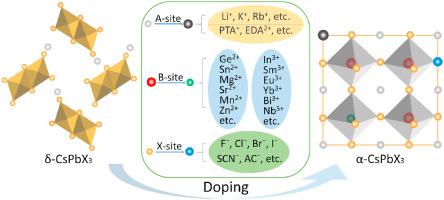Nano Energy ( IF 17.6 ) Pub Date : 2020-09-09 , DOI: 10.1016/j.nanoen.2020.105354 Xiaohui Ma , Liqun Yang , Kaixiang Lei , Shijian Zheng , Cong Chen , Hongwei Song

|
Perovskite solar cells (PSCs) have attracted tremendous interest because of their rushing improvement in power conversion efficiency (PCE) from the initial 3.8% to the most recently certified 25.2%. Despite the high efficiency of photovoltaic prospects, organic-inorganic hybrid perovskite materials with the requisite organic components are very sensitive and heterolytic under heat and humidity conditions. One of the promising methods to prepare inorganic perovskite solar cells (I–PSCs) by completely replacing the A-site organic cations in ABX3 structure has developed rapidly due to their excellent thermal and environmental stability. However, the phase instability of inorganic perovskite, especially for α‐CsPbI3, has been the bottleneck hindering their development in ambient conditions. Doping with new components is regarded as an effective method to assist the formation of high‐quality and stable inorganic perovskite films. The Gold-Schmidt tolerance factor t optimization or the intramolecular interaction between perovskite precursors with the new components has a substantial influence on the crystallization kinetics and the structural stability, while simultaneously offering the enhanced carrier transport characteristics and surface tension. Here, we systematically summarize the most recent research progress of inorganic perovskite and discuss strategies to overcome the phase instability from the perspective of doping for the first time. We also outlined the doped system of perovskite derivatives and summarized the application of the doped inorganic perovskite for photovoltaic application. Finally, we focus on prospecting the challenges and future research directions to achieve super-stable inorganic perovskites and their photovoltaics.
中文翻译:

在无机钙钛矿中掺杂以用于光伏应用
钙钛矿太阳能电池(PSC)引起了极大的兴趣,因为它们的功率转换效率(PCE)从最初的3.8%急速提高到最近认证的25.2%。尽管光伏技术前景看好,但具有所需有机成分的有机-无机杂化钙钛矿材料在热和湿条件下仍然非常敏感和杂化。通过完全替代ABX 3结构中的A位有机阳离子来制备无机钙钛矿太阳能电池(I–PSC)的一种有前途的方法因其出色的热稳定性和环境稳定性而迅速发展。然而,无机钙钛矿的相不稳定性,特别是对于α-CsPbI 3一直是阻碍其在环境条件下发展的瓶颈。掺杂新成分被认为是有助于形成高质量和稳定的无机钙钛矿薄膜的有效方法。金-施密特公差因子t钙钛矿前体与新组分之间的最佳优化或分子内相互作用对结晶动力学和结构稳定性有重大影响,同时提供增强的载流子传输特性和表面张力。在这里,我们系统地总结了无机钙钛矿的最新研究进展,并首次从掺杂的角度讨论了克服相不稳定性的策略。我们还概述了钙钛矿衍生物的掺杂体系,并总结了掺杂的无机钙钛矿在光伏应用中的应用。最后,我们专注于展望实现超稳定无机钙钛矿及其光伏材料的挑战和未来的研究方向。


























 京公网安备 11010802027423号
京公网安备 11010802027423号